

<< Go Back up to Region ‘United Kingdom: London’
| Follow Mike Hume’s Historic Theatre Photography: |  |
 |
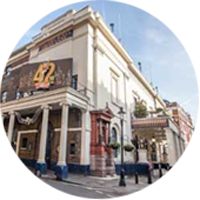
Architects: Christopher Wren (second theatre), Henry Holland (third theatre), John Linnell (third theatre assistant architect), Benjamin Dean Wyatt (current theatre)
Current (Fourth) Theatre Opened: 10th October 1812 (213 years ago)
First Theatre Opened: 7th May 1663
Second Theatre Opened: 26th March 1674
Third Theatre Opened: 21st April 1794
Reopened after major refurbishment: 23rd August 2021
Former Names: The Theatre Royal in Bridges Street, The King’s Playhouse, The Theatre Royal in Drury Lane
Website: www.theatreroyaldrurylane.co.uk 
Telephone: 0207 087 7760 
Address: Catherine Street, London, WC2B 5JF 
The current theatre building dates from 1812, however it is the fourth theatre building to have occupied the site, making this the oldest theatre site in London still in use today. The Drury Lane stage is the largest of any West End theatre and it has hosted many multi-year engagements, including a record-breaking 10-year run of “Miss Saigon”. The theatre is currently owned by noted composer Sir Andrew Lloyd-Webber’s LW Theatres group.

 Detailed Information
Detailed InformationThe Theatre Royal Drury Lane is one of the most important theatres in the world, with the site having been in theatrical use since 1663. The right to present dramatic entertainments dates from the Royal Patent granted by King Charles II to Thomas Killigrew in 1662, which is still in the possession of the theatre.
To this day the theatre’s name confuses those unfamiliar with it as its entrance is on Catherine Street...whereas Drury Lane is to the rear of the theatre.
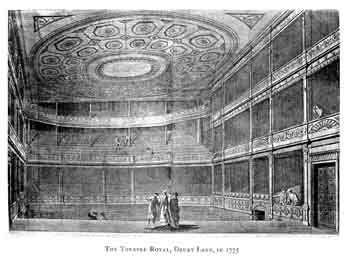
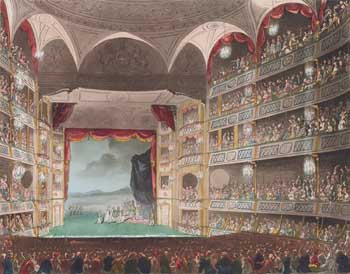
Current Building (1812)
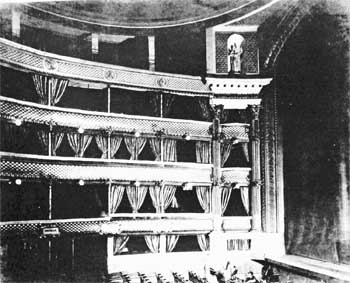
The current building, designed by Benjamin Dean Wyatt, opened on 10th October 1812. In 1820 the portico that still stands at the theatre’s front entrance on Catherine Street was added, and in 1831 the colonnade running down the Russell Street side of the building was added.
The entrance lobby opens into a central rotunda that is open to the higher levels with a gallery one level above. On either side of the rotunda are symmetrical grand staircases leading to the Royal Circle and Grand Saloon, the latter of which is located above the main lobby.
Following the unveiling of the third theatre where King George III attempted to box the Prince Regent’s ears, slapping him around the face, the theatre created separate sides to distance the warring King George III from the Prince Regent (later to become King George IV). The House Left side of the theatre is therefore designated as the King’s side, and House Right is the Prince’s side.
To this day the theatre maintains two Royal boxes, keeping the left for ‘the King’ and the right for ‘the Prince’, which are both adorned with their respective Royal crests. As part of the 2020’s renovation, seats in the auditorium were decorated with the King’s and Prince’s crest depending on which side of the theatre they fall within.
The theatre closed in September 1904 to undergo substantial renovations and improvements to the designs of Philip E. Pilditch, the consulting architect to the Marquess of Salisbury and the Duke of Bedford. The theatre reopened on 26th December (Boxing Day) 1904, with multiple new staircases added to assist the speedy entrance and exit of patrons, with combustible wooden features in the auditorium replaced with fibrous plaster. A massive new electrolier was hung from the center of the auditorium ceiling.
Backstage, ancient wooden traps in the stage floor were condemned, to be replaced by “metal devices” connected by galleries made of steel under the stage. Above the stage, the “numerous hempen ropes employed in the manipulation of scenery” were removed, replaced by steel wire and counterweights operated from new steel galleries on either side of the stage.
On 25th March 1908 a fire destroyed the stage and backstage areas. The fire was initially attributed to an electrical fault, however it was subsequently asserted that the building’s electrics were switched-off at 6pm the previous day and the fire alarm sounded at 3:20am the next morning. The auditorium and Front of House areas were saved by the lowering of the fire curtain and a fast response from fire crews. Most of the electrical system was renewed following the fire, an overview of which is documented here.
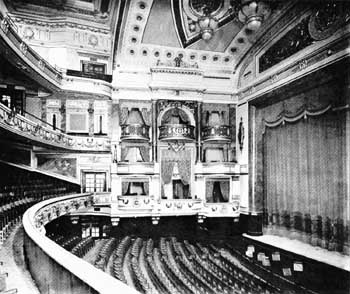
In 1922 a major interior renovation was undertaken at a cost of £150,000, resulting in the current auditorium arrangement of four levels of Stalls, Royal Circle, Grand Circle, and Gallery, accommodating just over 2,000 patrons. Interior decoration was by specialist ornamental plasterwork company Clark and Fenn, in what has become one of their most notable interiors.
The theatre was dark during the World War II when it was used as the home base for the Entertainments National Service Association. On 15th October 1940 the theatre took a direct hit from a gas bomb which tore through floors to the Stalls (main floor) level of the auditorium, however did not explode. The theatre reopened post-war on 19th December 1946.
Since 2005 Sir Andrew Lloyd-Webber’s Really Useful Theatre Group, now LW Theatres, has owned the theatre. On 7th May 2013, Lloyd-Webber revealed a £4 million restoration of the theatre to mark its 350th anniversary. The detailed restoration returned the public areas of the Rotunda, Royal Staircases, and Grand Saloon, all of which were part of the 1810 theatre, to their original Regency style.
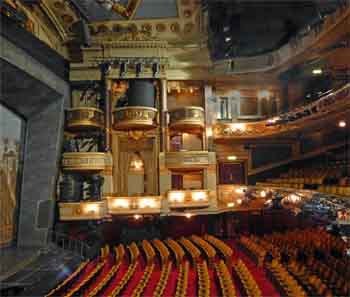
In late 2017 Westminster Council granted permission for an extensive renovation of the theatre which commenced in January 2019 and was expected to last 18-20 months. Access to the auditorium was to be greatly improved with increased toilet facilities and disabled access introduced. The stagehouse would be upgraded with a new grid and flying system. The raked (sloped) stage would be leveled to accommodate large-scale modern productions, and the theatre’s historic substage machinery (see Understage Machinery section below) would be removed after being documented. While it is sad that the historic machinery was removed, theatres are not museums and must adapt to accommodate the needs of modern theatrical productions. As the largest stage in London’s West End, Drury Lane had to adapt to accommodate the biggest and best productions for generations to come.
A large prop – yet practical – bell is hung backstage, usually in the Fly Floor area high above the stage, most likely left over from the 1972 production “Gone With The Wind”. Tradition has it that the bell is rung with the applause at the end of the final performance of a show’s run at the theatre. The bell was last rung on 5th January 2019 at the closing performance of “42nd Street”. The bell remained within the building during LW Theatres’ renovation and, thanks to long-term staff at the theatre, the tradition will continue to ring the bell during the curtain call of a show’s run’s final performance at the theatre.
It was announced in March 2019 that Disney’s Frozen  would reopen the theatre. Previews commenced 27th August 2021 (delayed from Autumn 2020 and then Spring 2021 due to the Covid-19 pandemic) with the official opening on 8th September 2021.
would reopen the theatre. Previews commenced 27th August 2021 (delayed from Autumn 2020 and then Spring 2021 due to the Covid-19 pandemic) with the official opening on 8th September 2021.
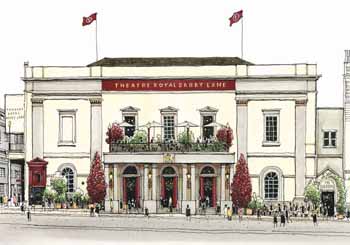
After a closure of approximately 30 months, the building reopened on 23rd July 2021 following its £60 million restoration, with free public access to The Garden, the Cecil Beaton Cocktail Bar, and the Rotunda Champagne Bar located in the base of the theatre’s magnificent rotunda.
With landscaping designed by Cameron Landscapes, The Garden  has soaring high ceilings, oversized chandeliers, indoor/outdoor seating, and offers a simple and seasonal curated menu. The Cecil Beaton Bar
has soaring high ceilings, oversized chandeliers, indoor/outdoor seating, and offers a simple and seasonal curated menu. The Cecil Beaton Bar  is named after high-society photographer and renowned costume designer Cecil Beaton. The elegant bar and lounge is open until late and does not require reservations. The Grand Saloon
is named after high-society photographer and renowned costume designer Cecil Beaton. The elegant bar and lounge is open until late and does not require reservations. The Grand Saloon  opened in September 2021 offering decadent afternoon tea. Further details are available at The Lane website
opened in September 2021 offering decadent afternoon tea. Further details are available at The Lane website  .
.
Notable long runs (over 1,000 performances) at Drury Lane:
Performance numbers were provided by the theatre; some online reports have conflicting numbers however their source is not known.
 Movie, TV & Music Video Appearances
Movie, TV & Music Video Appearances



 . As the Bolshoi Theatre, Moscow.
. As the Bolshoi Theatre, Moscow.
 . “Elephant - The Musical” theatre exterior.
. “Elephant - The Musical” theatre exterior.






 . Episode: Theatre Royal, Drury Lane (2004).
. Episode: Theatre Royal, Drury Lane (2004).
 . Episode: Theatre Royal, Drury Lane (2002).
. Episode: Theatre Royal, Drury Lane (2002). . Episodes: #1.1 (2013) and #1.3 (2013).
. Episodes: #1.1 (2013) and #1.3 (2013). . Episode: A Royal Flush (1986). Del, Rodney, Juney and Lady Victoria go to the theatre to watch “Carmen”.
. Episode: A Royal Flush (1986). Del, Rodney, Juney and Lady Victoria go to the theatre to watch “Carmen”.
 . Episodes: “Windsor” (2016) and “Smoke and Mirrors” (2016), as an unidentified theatre interior.
. Episodes: “Windsor” (2016) and “Smoke and Mirrors” (2016), as an unidentified theatre interior. . Episode: Live from London (2005).
. Episode: Live from London (2005).
 . Unknown episode.
. Unknown episode. . Episode: Shrek (2012).
. Episode: Shrek (2012).





 . Episode 8: Theatre Royal, Drury Lane.
. Episode 8: Theatre Royal, Drury Lane.




 Videos from our YouTube channel:
Videos from our YouTube channel: Listed/Landmark Building Status
Listed/Landmark Building Status (24th February 1958)
(24th February 1958) How do I visit the Theatre Royal, Drury Lane?
How do I visit the Theatre Royal, Drury Lane?Guided Tours are given in English and last approximately 1 hour. There are 20 spaces available per tour. Tours meet in the main foyer/lobby. Theatre Royal Drury Lane is a working theatre, so no two tours are the same. Sometimes the route will need to change due to other events taking place in the building. This is a walking tour with numerous steps and backstage areas so comfortable shoes are recommended.
Tour schedule: Wed & Fri: 10:30am, 12pm, 2:30pm. Thu & Sat: 10:30am, 12pm. Sun: 10:30am. Tickets £18.50 (no booking fee).
Booking line 020 7087 7748  , or online at the theatre’s tour website
, or online at the theatre’s tour website  , which also includes additional information about the tour.
, which also includes additional information about the tour.
 Further Reading
Further Reading , the premier Music Hall and Theatre History website in the UK.
, the premier Music Hall and Theatre History website in the UK. contains detailed history, drawings, a timeline of significant dates, and detailed history of the theatre.
contains detailed history, drawings, a timeline of significant dates, and detailed history of the theatre. contains a good summary, architectural description, and a selection of photographs not seen elsewhere.
contains a good summary, architectural description, and a selection of photographs not seen elsewhere. contains a selection of photographs not seen elsewhere, links to lighting plans from past shows, a detailed timeline of shows which have played at the theatre plus historical events, and links to information about technical equipment installed at the theatre.
contains a selection of photographs not seen elsewhere, links to lighting plans from past shows, a detailed timeline of shows which have played at the theatre plus historical events, and links to information about technical equipment installed at the theatre. by Benjamin Victor, held by the University of California and published online by the Internet Archive.
by Benjamin Victor, held by the University of California and published online by the Internet Archive. by Dorothea Restorations.
by Dorothea Restorations. , from 1663 to the present.
, from 1663 to the present. .
. .
. is dedicated to showcasing the building’s facilities and new spaces created during the theatre’s restoration, completed in 2021.
is dedicated to showcasing the building’s facilities and new spaces created during the theatre’s restoration, completed in 2021. as documented in pictures on the Dry Pigment blog
as documented in pictures on the Dry Pigment blog  .
. , by John Earl & Michael Sell, published by A&C Black. ISBN 0713656883.
, by John Earl & Michael Sell, published by A&C Black. ISBN 0713656883. , by Brian Dobbs, published by Cassell. ISBN 0304938599.
, by Brian Dobbs, published by Cassell. ISBN 0304938599. , by Richard Leacroft, published by E Methuen. ISBN 9780413288202.
, by Richard Leacroft, published by E Methuen. ISBN 9780413288202. , by Mike Kilburn and Alberto Arzoz, published by New Holland Publishers Uk Ltd. ISBN 1843300699.
, by Mike Kilburn and Alberto Arzoz, published by New Holland Publishers Uk Ltd. ISBN 1843300699. , by Michael Coveney and Peter Dazeley, published by France Lincoln. ISBN 0711238618.
, by Michael Coveney and Peter Dazeley, published by France Lincoln. ISBN 0711238618. Technical Information
Technical Information Photos of the Theatre Royal, Drury Lane
Photos of the Theatre Royal, Drury LanePhotographs copyright © 2002-2025 Mike Hume / Historic Theatre Photos unless otherwise noted.
Text copyright © 2017-2025 Mike Hume / Historic Theatre Photos.
For photograph licensing and/or re-use contact us here  . See our Sharing Guidelines here
. See our Sharing Guidelines here  .
.
| Follow Mike Hume’s Historic Theatre Photography: |  |
 |